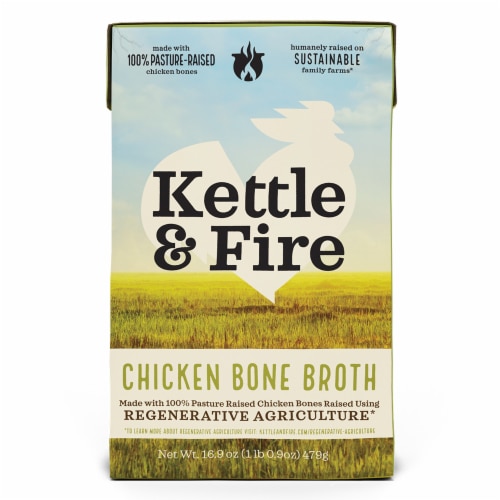Kettle & Fire Gluten Free Non-GMO Bone Broth Regenerative Agriculture Chicken Description
- 20g Protein
- 90 Calories
- 3g Net Carbs
- Gluten Free
- Paleo Friendly
- Non-GMO
- Dairy Free
- Keto Friendly
- Glyphosphate Residue Free
Our Regenerative Agriculture Movement
At Kettle & Fire, we're committed to a healthier food system and a healthier planet. We believe Regenerative Agriculture has the potential to not only save the planet but reverse climate change.
-
Comforting sips of pasture-raised chicken, flavorful vegetables, & fragrant herbs.
-
Premium ingredients sourced from regenerative farms
-
Collagen, glycine, & other nutrients preserved via a slow simmer
-
As always: no artificial additives, harmful herbicides, or potent pesticides
Directions
How to Enjoy Beef Broths:
Our bone broths have inviting, mild flavors making them easier to sip daily or add to your favorite recipes. For enhanced flavor experiences, spice them up to suit your taste buds!
Sip
Drinking bone broth is a great way to start your day. Pour into stovetop safe cookware or microwave safe dish and heat to desired temp with preferred method. (Give it a stir! Natural ingredients may settle or be present on top.)
Stir
Your bone broth, your way. Customize to fit your tastes: add ginger, garlic, turmeric, cayenne, or any other spices or toppings you want; use as an alternative to stock in your favorite recipes; or, replace water when cooking things like rice or soaking dried beans. See our ?recipe library? for more inspiration!
Smile
You’ll be happy knowing that your body is receiving much-needed collagen every time you drink bone broth. We recommend at least 3 cups per week (optimal consumption is part of your daily diet) to help boost protein intake, reduce cravings, and provide support for your needs.
Free Of
Gluten, preservatives, artificial additives, harmful herbicides, pesticides, dairy.
*These statements have not been evaluated by the Food and Drug Administration. This product is not intended to diagnose, treat, cure, or prevent any disease.
Nutrition Facts
Serving Size: 1 Container (479 g)
Servings per Container: 1
| Amount Per Serving | % Daily Value |
|
| Calories | 90 | |
|
| Total Fat | 0 g | 0% |
|
| Saturated Fat | 0 g | 0% |
|
| Trans Fat | 0 g | |
|
| Cholesterol | 0 mg | 0% |
|
| Sodium | 650 mg | 28% |
|
| Total Carbohydrate | 3 g | 1% |
|
| Dietary Fiber Less Than | 1 g | 2% |
|
| Total Sugars | 0 g | |
|
| Includes 0g Added Sugars | | 0% |
|
| Protein | 20 g | 3% |
|
| Vitamin D | 0 mcg | 0% |
|
| Calcium | 50 mg | 0% |
|
| Iron | 0 mg | 0% |
|
| Potassium | 750 mg | 15% |
|
Other Ingredients: Chicken bone broth (water, pasture rasied chicken bones, organic onions, organic carrots, organic fennel, organic leeks, organic apple cider vinegar, organic thyme, organic shiitake mushrooms, organic tamarind paste, organic bay leaves), organic vegetable broth (organic celery, organic green bell peppers, organic onions, organic carrots, organic garlic, organic scallions, organic tamato puree (organic tomato paste, water), organic parsley, organic thyme, organic rosemary, organic basil, organic spices), sea salt.
The product you receive may contain additional details or differ from what is shown on this page, or the product may have additional information revealed by partially peeling back the label. We recommend you reference the complete information included with your product before consumption and do not rely solely on the details shown on this page. For more information, please see our
full disclaimer.
Reviews
View printable version
Print Page
Easy Gluten-Free Stelline Soup
[vc_row][vc_column][vc_column_text]This stelline soup is a simple, wholesome twist on a classic chicken and stars soup. Made with Jovial’s award-winning organic brown rice stelline pasta, this recipe is naturally gluten-free yet full of traditional Italian flavor. The tiny star-shaped pasta (“stelline” is Italian for "little stars") makes it cozy and fun, while the simple blend of chicken broth and herbs keeps it nourishing and satisfying. Every spoonful delivers warmth, nostalgia and easy goodness.

Easy Gluten-Free Stelline Soup

- 16 cups (128 oz.) chicken broth
- 12 oz. Jovial Organic Brown Rice Pasta - Gluten-Free Stelline
- Sea salt (to taste)
- Black pepper (to taste)
- 2-3 sprigs thyme (or 4-5 bay leaves, or herb of choice)
- Grated Parmigiano-Reggiano cheese (optional)
- In soup pot, bring chicken broth to boil.
- Stir stelline pasta into chicken broth and cook 10 minutes. (Note: Cooking pasta directly in broth will make the soup more flavorful.)
- Add thyme sprigs or herbs of choice during cooking process but remove before serving.
- Sprinkle with Parmigiano-Reggiano cheese and serve.
Get the wholesome ingredients you’ll need from Vitacost.

[/vc_column_text][/vc_column][/vc_row][vc_row][vc_column][vc_text_separator title="Featured Products" border_width="2"][vc_row_inner equal_height="yes" content_placement="middle" gap="35"][vc_column_inner width="1/3"][vc_single_image image="188018" img_size="full" alignment="center" onclick="custom_link" img_link_target="_blank" css=".vc_custom_1757967679930{padding-right: 7% !important;padding-left: 7% !important;}" link="https://www.vitacost.com/jovial-organic-brown-rice-pasta-gluten-free-stelline"][/vc_column_inner][vc_column_inner width="1/3"][vc_single_image image="188017" img_size="full" alignment="center" onclick="custom_link" img_link_target="_blank" css=".vc_custom_1757967705020{padding-right: 7% !important;padding-left: 7% !important;}" link="https://www.vitacost.com/imagine-foods-organic-free-range-chicken-broth-32-fl-oz"][/vc_column_inner][vc_column_inner width="1/3"][vc_single_image image="188019" img_size="full" alignment="center" onclick="custom_link" img_link_target="_blank" css=".vc_custom_1757967726083{padding-right: 7% !important;padding-left: 7% !important;}" link="https://www.vitacost.com/selina-naturally-celtic-sea-salt-grinder"][/vc_column_inner][/vc_row_inner][/vc_column][/vc_row]





